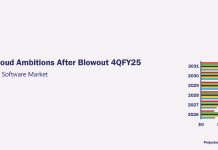As an avid enterprise IT watcher, I am constantly amazed at the uncanny ability of Oracle to reinvent itself after relying on its bread-and-butter database software for more than 35 years.
It is a classic tale of how one company refuses to give in, despite the increasing odds that stack against its core business. When one part of the company is in trouble, it quickly plugs the hole with a quick fix while scrambling for long-term solutions. When its customers are clamoring for Cloud offerings, Oracle wastes no time to meet their needs.
Recently Oracle’s accelerated push to embrace the Cloud has taken on a new urgency. In rapid fashion, Oracle has announced plans to acquire social marketing outfit Vitrue, social intelligence aggregator Collective Intellect, social markup language developer Involver, clinical-trial operations specialist ClearTrial, network virtualization vendor Xsigo, and facilities management provider Skire. That’s on top of its acquisitions of RightNow and Taleo spending billions of dollars along the way on eight deals in less than eight months.
Despite the moves, there are signs that the company has reached its limits on how to grow its core business, while moving aggressively to turn around the Sun hardware operations that it acquired in April 2009 at the risks of alienating long-time partners like HP.
Recently a California judge ruled in favor of HP’s Itanium suit against Oracle, throwing another monkey wrench into Oracle’s quest to become a provider of complete technology stack from database to applications and from middleware to servers.
Additionally, Oracle’s performance in the fourth quarter – traditionally its best and the brightest – of fiscal 2012 paled that of its closest competitor SAP. SAP’s 18% jump in total revenues in 2Q12 eclipsed Oracle’s 1.8% gain in 4Q12 by a long shot.
The stark contrast cut across all regions. Bogged down by its sluggish hardware business, Oracle’s software license revenues rose 14% in the Americas, dropped 5% in EMEA and gained 8% in Asia Pacific during the quarter. SAP outperformed Oracle in all three regions with increases of 32%, 22% and 25%, respectively.
In Japan Oracle’s total revenues posted a modest 6% rise, compared with the 27% spike for SAP Japan. The former is twice the size of SAP Japan.
Based on our estimates, Oracle applications and middleware business in the United States was one of the rare bright spots in 4Q12, but that was largely because of incremental revenues from its recent acquisitions, which target mostly US customers.
Decelerating Database
A more unsettling, yet unavoidable, trend is the slowdown of its core database business, which until 2006 accounted for the bulk of its license and maintenance revenues. Clearly the 2005 acquisition of PeopleSoft was the catalyst that shifted the priorities of the company, or the mindshare of its customers for that matter. Its multiple acquisitions in the middleware space pushed database further away from the spotlight.
For example, Endeca, the search technology acquired in October 2011, and Fatwire, acquired in June 2011 and now part of Oracle WebCenter for Web Experience Management, helped contributed $63 million in Middleware license revenues in 4Q12. That followed growing revenue contributions from Sun Middleware as well as a host of others like AmberPoint, Datanomic, GoldenGate, Passlogix, and Silver Creek Systems.
The last major deal Oracle did in database was the acquisition of Sun, which brought with it MySQL, an open source database, which means anyone can download it for free. The highest list price of a commercial license of MySQL from Oracle is $20,000, compared with $47,500 for the Oracle Database Enterprise Edition. If you are one of the thousands of Oracle salespeople, which one would you sell. Based on our research, for every dollar Oracle gets from MySQL license sales, it gets $35 to $40 from its core database licenses.
That raises the question of the future of Oracle database business, which has been the growth engine for much of its history. CEO Larry Ellison likes to point out that Oracle got its start by selling secure databases to the CIA, not selling secure applications or secure Cloud products to anyone who puts their faith on its products.
The truth is that Oracle’s database business is not secure anymore. Until FY 2009, SAP and HP were among Oracle’s 10 biggest database resellers, accounting for $147 million and $43 million in revenues, respectively, according to transcripts from the lawsuit filed by HP against Oracle for withdrawing product support for HP’s Itanium server customers.
Assuming a drop in FY10 because of the recession and a rebound in FY11, both companies could still represent at least $200 million in annual revenues for Oracle. A pittance perhaps when one compares that with an estimated $4 billion in database license revenues Oracle gets every year.
Both SAP and HP are forgoing the sale of Oracle database to their customers, the former now in favor of its own database Sybase ASE as well as a high-performance alternative called SAP HANA, and the latter is locked in a hostile hardware battle against Oracle, its erstwhile partner.
Database Commodity
The problem is that once you open the floodgate letting in non believers, you will never recover after they start using cheaper but equally compelling substitutes. It wasn’t too long when one would question the value of a generic cholesterol-reducing drug vs that of Pfizer Lipitor. Now people couldn’t care less if they wipe their nose with a store-brand tissue or Kleenex. In the new era of Big Data, what’s important is not the database one uses, but rather how you can make sense of the massive data repository in real time. Coincidentally 4Q12 was the first quarter in a long time when we saw deterioration in Oracle’s core database business, judging from the flat license revenues of its database and middleware products.
It’s possible that Oracle could revive sales of its database by bundling it with its hardware perhaps at a steep discount. After all, Oracle has done it recently by dangling 10 Exadata boxes plus five-year maintenance for free in front of Alcoa hoping that to dissuade it from adding more HP servers. Again that’s from the transcripts of the HP and Oracle trial.
Anyone who contemplates giving away Oracle’s crown jewel should have their head reexamined. For one thing doing that would suggest that Oracle’s high-end hardware strategy is losing more ground to competitors like EMC Greenplum, HP Vertica, IBM Netezza and Teradata Aster Data, after its reduced expectations of Exaline business made during its 3Q12 earnings call.
Since IBM acquired Netezza in 2010, it has grown its installed base by 40% from 370 to more than 525. In recent months IBM has sold out all of its Netezza. The real problem with Oracle’s hardware strategy, especially on the high end, is that it’s competing with enemies on all fronts and the safest place for its salespeople to call on remains its installed base of database customers, which may start shrinking.
By comparison, IBM Netezza can be sold not only to its Cognos, Infosphere customers, but also those using Microstrategy or Informatica, while HP Vertica can be easily plugged into Microsoft SQL Server accounts. EMC Greenplum is aligning itself with SAS. With more customers than Oracle Exadata, Teradata can sell to any of its estimated 1,500 longtime data warehouse accounts. In other words, Oracle is fighting with everyone all at once just to get into the door.
To help Oracle solve its current predicament, my advice is as follows:
Defend its core database business at all costs, which mean that it needs to identify a loss leader among its vast product portfolio. It could be something like Hyperion Essbase for reporting or Golden Gate for enterprise information management. Deploy that tactic judiciously to help sell its hardware, database, or applications products.
If it fails to grow its hardware business as it promises to do in the current fiscal year, license the technology liberally to anyone who wants to put it into the data center of the future, expanding that into an Intel Inside-like program powered by Oracle Engineered Systems. If that still doesn’t work, sell the hardware business to the Chinese.
It’s time for company cofounder Larry Ellison, who turned 68 on August 17, to articulate a succession plan. It may be painful for Ellison, who probably has many more things that he wants to accomplish in his remaining years, to give up control. However relinquishing his CEO position would be imperative for Oracle to stake its future away from its database, another crucial step for the company to reinvent itself.
Oracle is no longer a database company anymore. Since its acquisition of PeopleSoft, Oracle has been locking horns with others in the Enterprise Resource Management space. To stay buzzword-compliant, Oracle should align all its products with the Enterprise Cloud in mind. Database just happens to be one of the resources that the enterprise needs to better manage in the Cloud.
The new reality is that it needs to position itself as the technology vendor most capable of harnessing the Enterprise Cloud backed by its long history of developing its basic building block.






